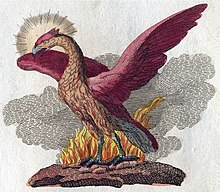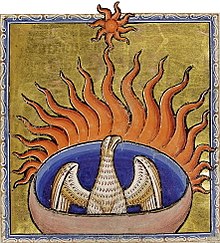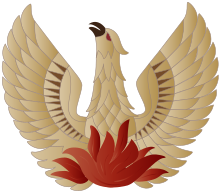Phoenix (Mythology)
For other uses, see Phoenix (disambiguation).
In Ancient Greek folklore, a phoenix (/ˈfiːnɪks/; Ancient Greek: φοῖνιξ, phoînix) is a long-lived bird that cyclically regenerates or is otherwise born again. Associated with the sun, a phoenix obtains new life by arising from the ashes of its predecessor. Some legends say it dies in a show of flames and combustion, others that it simply dies and decomposes before being born again.[1]
Over time the phoenix motif spread from its origins in classical folklore and gained a variety of new associations: Herodotus, Lucan, Pliny the Elder, Pope Clement I, Lactantius, Ovid, and Isidore of Seville are among those who have contributed to the retelling and transmission of the phoenix motif. Over time, extending beyond its origins in classical Greek folklore, the phoenix could variously "symbolize renewal in general as well as the sun, time, the Empire, metempsychosis, consecration, resurrection, life in the heavenly Paradise, Christ, Mary, virginity, the exceptional man, and certain aspects of Christian life".[2] In the Motif-Index of Folk-Literature, a tool used by folklorists, the phoenix is classified as motif B32.[3]
Etymology[edit]
The modern English word phoenix enters the English language from Latin, later reinforced by French. The word first enters the English language by way of a borrowing of Latin phoenīx into Old English (fenix). This borrowing was later reinforced by French influence, which had also borrowed the Latin noun. In time, the word developed specialized use in the English language: For example, the term could refer to an "excellent person" (12th century), a variety of heraldic emblem (15th century), and the name of a constellation (17th century).[4]
The Latin word comes from Greek φοῖνιξ phoinīx.[5] The Greek word is first attested in the Mycenaean Greek po-ni-ke, which probably meant 'griffin', though it might have meant 'palm tree'. That word is probably a borrowing from a West Semitic word for madder, a red dye made from Rubia tinctorum. The word Phoenician appears to be from the same root, meaning 'those who work with red dyes'. So phoenix may mean 'the Phoenician bird' or 'the purplish-red bird'.[6]
Early texts[edit]
Exterior to the Linear B mention above from Mycenean Greece in which the entity is referred to as a griffin-like entity, the earliest clear mention of the phoenix in ancient Greek literature occurs in a fragment of the Precepts of Chiron, attributed to 6th century BC Greek poet Hesiod. In the fragment, the wise centaur Chiron tells a young hero Achilles the following:
Classical discourse on the subject of the phoenix attributes a potential origin of the phoenix to Ancient Egypt. Herodotus, writing in the 5th century BC, provides the following account of the phoenix:
In the 19th century, scholastic suspicions appeared to be confirmed by the discovery that Egyptians in Heliopolis had venerated the Bennu, a solar bird similar in some respects to the Greek phoenix. However, the Egyptian sources regarding the bennu are often problematic and open to a variety of interpretations. Some of these sources may have actually been influenced by Greek notions of the phoenix, rather than the other way around.[9]
Depictions[edit]
The phoenix is sometimes pictured in ancient and medieval literature and medieval art as endowed with a halo, which emphasizes the bird's connection with the Sun.[10] In the oldest images of phoenixes on record these nimbuses often have seven rays, like Helios (the Greek personification of the Sun).[11] Pliny the Elder[12] also describes the bird as having a crest of feathers on its head,[10] and Ezekiel the Dramatist compared it to a rooster.[13]
The phoenix came to be associated with specific colors over time. Although the phoenix was generally believed to be colorful and vibrant, sources provide no clear consensus about its coloration. Tacitus says that its color made it stand out from all other birds.[14] Some said that the bird had peacock-like coloring, and Herodotus's claim of the Phoenix being red and yellow is popular in many versions of the story on record.[15] Ezekiel the Dramatist declared that the phoenix had red legs and striking yellow eyes,[13] but Lactantius said that its eyes were blue like sapphires[16] and that its legs were covered in yellow-gold scales with rose-colored talons.[17]
Herodotus, Pliny, Solinus, and Philostratus describe the phoenix as similar in size to an eagle,[18] but Lactantius and Ezekiel the Dramatist both claim that the phoenix was larger, with Lactantius declaring that it was even larger than an ostrich.[19]
Diffusion in later culture[edit]
In time, the motif and concept of the phoenix extended from its origins in ancient Greek folklore. For example, the classical motif of the phoenix continues into the Gnostic manuscript On the Origin of the World from the Nag Hammadi Library collection in Egypt generally dated to the 4th century:
The anonymous 10th century Old English Exeter Book contains an anonymous 677-line 9th-century alliterative poem consisting of a paraphrase and abbreviation of Lactantius, followed by an explication of the Phoenix as an allegory for the resurrection of Christ.[21]
Þisses fugles gecynd fela gelices | This bird's nature is much like |
| —In the original Old English | —In Modern English translation (1842)[22] |
In the 14th century, Italian poet Dante Alighieri refers to the phoenix in Inferno Canto XXIV:
Così per li gran savi si confessa | Even thus by the great sages 'tis confessed |
| —In the original Italian | —In English translation |
In the 17th century play Henry VIII by English playwrights William Shakespeare and John Fletcher, Archbishop Cranmer says in Act V, Scene v in reference to Elizabeth (who was to become Queen Elizabeth I):
Phoenixes are present and relatively common in European heraldry, which developed during the High Middle Ages. They most often appear as crests, and more rarely as charges. The heraldic phoenix is depicted as the head, chest and wings of an eagle rising from a fire; the entire creature is never depicted.[23]
Modern popular culture[edit]
In the modern era, the phoenix motif continues to see use in a variety of contexts. Elon University's sports teams became known as the Phoenix in 2000, stemming from the colleges fire and subsequent recovery in 1923. University trustees at the time announced their intentions to make Elon "rise from the ashes".
Swarthmore College's newspaper has been named "The Phoenix" since the college's fire in 1881[24]; the phoenix bird was considered emblematic of the college's rebirth from its ashes. More recently, "Phineas the Phoenix" has become the official mascot[25] of Swarthmore College, with a dancing student inside a costume of plush plumage.
The flag of San Francisco, California features a phoenix in its center, symbolic of the city’s rebuilding following the 1906 San Francisco earthquake.
The club crest of Coventry City Football Club features a phoenix rising from the flames, in recognition of how the City of Coventry was rebuilt after being destroyed by the Nazi German Luftwaffe during the Blitz bombing campaigns of World War 2.
Coventry University use a phoenix rising from the flames as their emblem, tying in with the city they are based, and the same reason Coventry City Football Club carry a phoenix on their club crest.
Analogues[edit]
Scholars have observed analogues to the phoenix in a variety of cultures. These analogues include the Hindu garuda (गरुड) and bherunda (भेरुण्ड), the Russian firebird, the Persian simorgh (سیمرغ), the Georgian paskunji, the Arabian anqa (عنقاء), the Turkish Konrul, also called Zümrüdü Anka ("emerald anqa"), the Tibetan Me byi karmo, the Chinese Fenghuang (鳳凰) and zhu que (朱雀), and the Japanese hō-ō (鳳凰).[26] These perceived analogues are sometimes included as part of the Motif-Index of Folk-Literature phoenix motif (B32).[3]
See also[edit]
- Phoenix in popular culture
- Chalkydri
- Chol (Bible), a Hebrew word sometimes glossed as phoenix
Notes[edit]
- ^ Van der Broek 1972, p. 146.
- ^ Van der Broek 1972, p. 9.
- ^ a b Thompson (2001: 581).
- ^ "phoenix, n.1". OED Online. September 2020. Oxford University Press. https://www.oed.com/view/Entry/142601?rskey=BIj1L3&result=1&isAdvanced=false(accessed November 06, 2020).
- ^ Barnhart 1995, p. 564.
- ^ Van der Broek 1972, p. 62–66.
- ^ Evelyn-White (1920: 75-75).
- ^ Herodotus, The Histories (1858 translation), Book II Trans. G. Rawlinson (1858)
- ^ Van der Broek 1972, p. 14–25.
- ^ a b Van der Broek 1972, p. 233.
- ^ Van der Broek 1972, pp. 246–247.
- ^ Ancient Magic and the Supernatural in the Modern Visual and Performing Arts, edited by Filippo Carlà-Uhink, Irene Berti, 2016, page 172
- ^ a b Van der Broek 1972, p. 257.
- ^ Van der Broek 1972, p. 253.
- ^ Van der Broek 1972, p. 259.
- ^ Van der Broek 1972, p. 256.
- ^ Van der Broek 1972, pp. 257–258.
- ^ Van der Broek 1972, p. 251.
- ^ Van der Broek 1972, p. 252.
- ^ James M. Robinson (1988). The Nag Hammadi Library. pp. 291-292. HarperCollins Publishers.
- ^ Blake 1964, p. 1.
- ^ Thorpe, Benjamin; Corson, Hiram (1842). "Codex exoniensis. A collection of Anglo-Saxon poetry, from a manuscript in the library of the dean and chapter of Exeter". p. 244. Retrieved 9 December 2018.
- ^ Arthur Fox-Davies, A Complete Guide to Heraldry, T.C. and E.C. Jack, London, 1909, 240, https://archive.org/details/completeguidetoh00foxduoft.
- ^ "1882 The Phoenix Founded". www.swarthmore.edu. 2016-05-13. Retrieved 2020-01-03.
- ^ "The Phoenix". www.swarthmore.edu. 2014-07-08. Retrieved 2020-01-03.
- ^ Garry & El-Shamy 2005, pp. 84–87.
References[edit]
- Barnhart, Robert K (1995), The Barnhart Concise Dictionary of Etymology, HarperCollins, ISBN 0-06-270084-7.
- Blake, N F (1964), The Phoenix, Manchester: Manchester U Press.
- Evelyn-White, Hugh G. Trans. 1920. Hesiod: The Homeric Hymns and Homerica. London: William Heinemann & New York: G.P. Putnam's Sons.
- Garry, Jane; El-Shamy, Hasan (2005), Archetypes and Motifs in Folklore and Literature, ME Sharpe, ISBN 978-0-76561260-1.
- Thompson, Stith. 2001. Motif-Index of Folk-Literature: A Classification of Narrative Elements in Folk Tales, Ballads, Myths, Fables, Mediaeval Romances, Exempla, Fabliaux, Jest-Books, and Local Legends, Volume 1; Volume 6. Indiana University Press. 9780253340894
- Van der Broek, R (1972), The Myth of the Phoenix, Seeger, I trans, EJ Brill.



Comments
Post a Comment